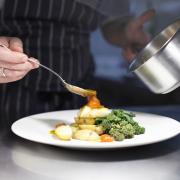Wilmslow's past can be seen in its pubs. The fabric and stories of the hostelries offer clues about this town's history. Words by Mike Smiths Main photography by John Cocks
Through their name, their origin or the stories associated with them, public houses offer some of the best clues to a town’s past.But historical sleuthing in the pubs of Wilmslow is not quite so straightforward because so many of its traditional public houses have been converted into wine bars or up-market restaurants.
Nonetheless, the clues are still there, particularly in four of the most popular eating and drinking places in the town.
The Bollin Fee, at the busy junction of Swan Street and Alderley Road, is the former Grape and Grain, created in the first instance by a merger of three premises, including Isaac Warburton’s well known grocer’s shop, which had stood on the site since the 1880s. As a wall plaque explains, the present name of the pub is a reference to the old civil parish of Bollin-fee, which was amalgamated with Fulshaw, Chorley and part of Pownall-fee to form the brand new parish of Wilmslow in 1894.
Completely refurbished by the Wetherspoon group in 2010, the pub is popular from early morning until late at night as a place to eat and drink. Its spacious interior is supplemented by a stylish outdoor seating area, where it is possible to watch the world going by while being quarantined from the busy road by a glass panel. Local resident Stacey Jackson and her sister, Victoria Pemberton from Lymm, told me: ‘When the weather is good, we love coming to this great patio area to enjoy our regular lunchtime get-togethers.’
Although Wilmslow is a very young town, St Bartholomew’s Church, which is tucked into a hollow below the pub, dates back to the 16th century. As might be expected, the first rectors lived close to the church, but later incumbents were given accommodation near the junction of Swan Street and Alderley Road. This is the plot of land where Rev Edward Beresford decided to build himself a very grand new rectory in 1778.
Like many clergymen of the Church of England in the late 18th century, Rev. Beresford enjoyed the lifestyle of a country gentleman. According to an entry in the book ‘Cheshire Within Living Memory’, Wilmslow’s rectors continued to lead this privileged way of life well into the 20th century. One member of the Local Women’s Institute recalls: ‘Our rector in those days seemed a very remote figure, especially as he was driven round in his horse and trap.’
In more recent times, the imposing 18th century rectory has served as an area office for the National Westminster Bank and then as a pub called The Rectory. In 2010, the building was given a very stylish interior makeover, losing its name in the process and becoming an eating place of choice. Explaining why the pub’s old name was dropped, assistant manager Dominic Molloy said: ‘All the 27 restaurants in our nationwide chain have been rebranded quite simply as Miller and Carter Steakhouses. The name tells customers that they are guaranteed high-quality food.’
One public house in Wilmslow that has not been substantially altered or given a change of name in recent years is The Swan, which stands on Swan Lane, adjacent to the Bollin Fee. The exterior is largely original, the interior is traditional in appearance and the pub even plays host to the sort of pub games that people used to enjoy in their local.
Assistant manager Karen Shelmerdine said: ‘The first floor of the building, where I have my accommodation, is like a rabbit warren because most of the original walls and rooms are still intact. We believe The Swan is one of the oldest public houses in Wilmslow and that it came into being as a coaching inn on the Manchester to London turnpike. ‘
The construction of the turnpike in 1753 prompted the establishment of other pubs in the area, such as the New Inn on Alderley Road. This old coaching inn was refurbished in 2002, when it was re-christened the Coach and Four following a competition involving readers of the Wilmslow Express, some of whom may well have remembered Arthur Holden’s coach and four still operating from the pub in the 1930s.
Although the coming of the turnpike gave a big boost to local trade, it was the arrival of the railway line in 1842 that really kick-started Wilmslow’s rapid development as a commuter town and led to its becoming one of the most desirable places of residence, not only in Cheshire but in the whole of England.


























